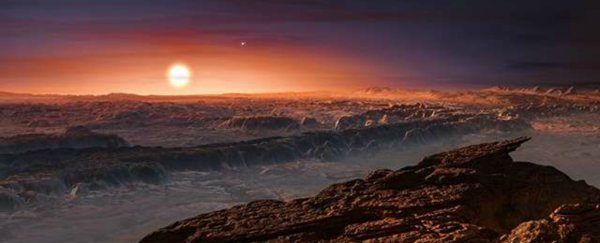Back in August, scientists gave life to our wildest dreams by announcing the discovery of an Earth-like planet called Proxima b within our closest neighbouring star system. Since then, scientists have hinted that the planet could have a breathable atmosphere, and it might be covered in water.
Now a new study offers us both good and bad news. The bad? The planet is likely being pummelled regularly by "extinction-level" stellar flares. But despite that, simulations show that the planet could still host life.
The range of simulations have shown that if Proxima b has an atmosphere or magnetic field similar to Earth's, then life on its surface could be possible. But without that protective barrier, any life on the surface would most likely be regularly wiped out.
Let's take a step back for a second though and talk about Proxima b. Proxima b is so exciting because it's the closest Earth-like planet candidate we've ever found, at only 4.25 light-years away - or 40 trillion kilometres.
That might not sound very nearby, but before its discovery, the closest Earth-like planet was a whopping 14 light-years away. Proxima b might be outside the range of our probes for now, but with advances in space travel, it's likely that we'll eventually be able to visit.
In fact, a Russian billionaire already has a plan to visit the planet by 2060.
And that's good news, because the planet is in the 'Goldilocks zone' of its host star - which means it's close enough to have liquid water, but not so close that it would have all boiled away. Researchers think it might even be habitable.
The star orbits Proxima Centauri, which is part of the Alpha Centauri star system, and is roughly 1.3 times the size of Earth. With its 11.2-day orbit around its star, the best estimates put its surface temperature at –40 degrees Celsius.
But there's on big problem. A new study has shown that the planet could face regular extinction-level events in the form of huge stellar flares. Just like the solar storms that we experience here on Earth, Proxima b could be pummelled by these energetic events.
Earth is protected from these events by our magnetic field and thick atmosphere, but it's not clear if Proxima b would be too close to its star to make it out unscathed.
Since the discovery of the planet, astrobiologist Dimitra Atri from the Blue Marble Institute of Space Science in Seattle has been running simulations on just how likely those flares are - and whether or not there's a way life could survive on the surface.
His results show that Proxima b might not be quite as habitable as we originally thought, depending on its atmosphere.
"I would say that it is too premature to call Proxima b habitable," Atri told Space.com. "There are many factors that would decide whether such a planet can sustain a biosphere. More data will help clarify the situation."
To figure out how life on the planet would hold up, Atri took into account the type and size of stellar flares that we know of in the Universe; how thick the planet's atmosphere could be; and the strength of its magnetic field - which is a key component in shielding planets from solar wind.
His calculations showed that all Proxima b needs to be habitable is an atmosphere and magnetic field similar to Earth's.
But on the other hand, if the planet ends up having a thin atmosphere or no magnetic field, then it might not be as promising a place for life as we'd hoped.
Until we get a chance to check out the planet more closely - either ourselves or with a high-power telescope - we won't have answers any time soon.
But Atri does not that these results all assume that the life on the planet would similar to life here on Earth. If the planet was covered in super-resilient microbes, then it could be a whole different story - and this is a scenario he's planning to investigate next.
"One important aspect of this work is highlighting the critical importance of having a significant planetary magnetic field and good atmospheric shielding," Atri told Space.com.
"With these two factors, even the most extreme stellar flares will not have much impact on a primitive biosphere."
The study has been published in the Monthly Notices of the Royal Astronomical Society.
